- Wondering how to get Monopoly GO! free rolls? Well, you’ve come to the right place. In this guide, we provide you with a bunch of tips and tricks to get some free rolls for the hit new mobile game. We’ll …
The BEST Roblox Games of The Week – Games You Need To Play!
By Sho Roberts
Our feature shares our pick for the Best Roblox Games of the week! With our feature, we guarantee you'll find something new to play!All Grades in Type Soul – Each Race Explained
By Adele Wilson
Our All Grades in Type Soul guide lists every grade in the game for all races, including how to increase your grade quickly!Best Roblox Horror Games to Play Right Now – Updated Weekly
By Adele Wilson
Our Best Roblox Horror Games guide features the scariest and most creative experiences to play right now on the platform!
Animal Crossing: Pocket Camp Review – Home Again
On the long list of games and series we’ve hoped would make their way to mobile, Animal Crossing stands at the top. Its open-ended, laid back gameplay has always been designed to allow players to come and leave as they …
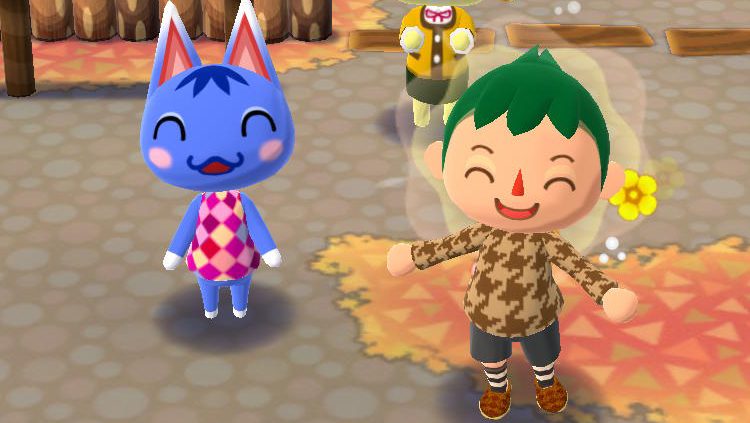
On the long list of games and series we’ve hoped would make their way to mobile, Animal Crossing stands at the top. Its open-ended, laid back gameplay has always been designed to allow players to come and leave as they please, making it a perfect fit for the drop-in-and-out style of on-the-go-gaming. The fact that the series takes place in real time, complete with season-specific items and holiday events, makes it an ideal candidate for quick check-ins on a device that’s always with you. And most importantly, we’ve become attached to many of its characters over the years and are always looking for a new and convenient way to visit with them again.
Pocket Camp makes use of all these features in an experience that is both distinctly Animal Crossing and specifically crafted for mobile. It takes the things most players love about the series—its freedom, design elements, collectibles, and endearing animals—and folds them into a more condensed, goal-oriented package. While you’re still free to play as you like and pursue whichever objectives interest you—whether that’s stockpiling fish, rearranging furniture, or being a social butterfly—it’s easier to track the results of your efforts thanks to distinct, measured friendship and experience levels.
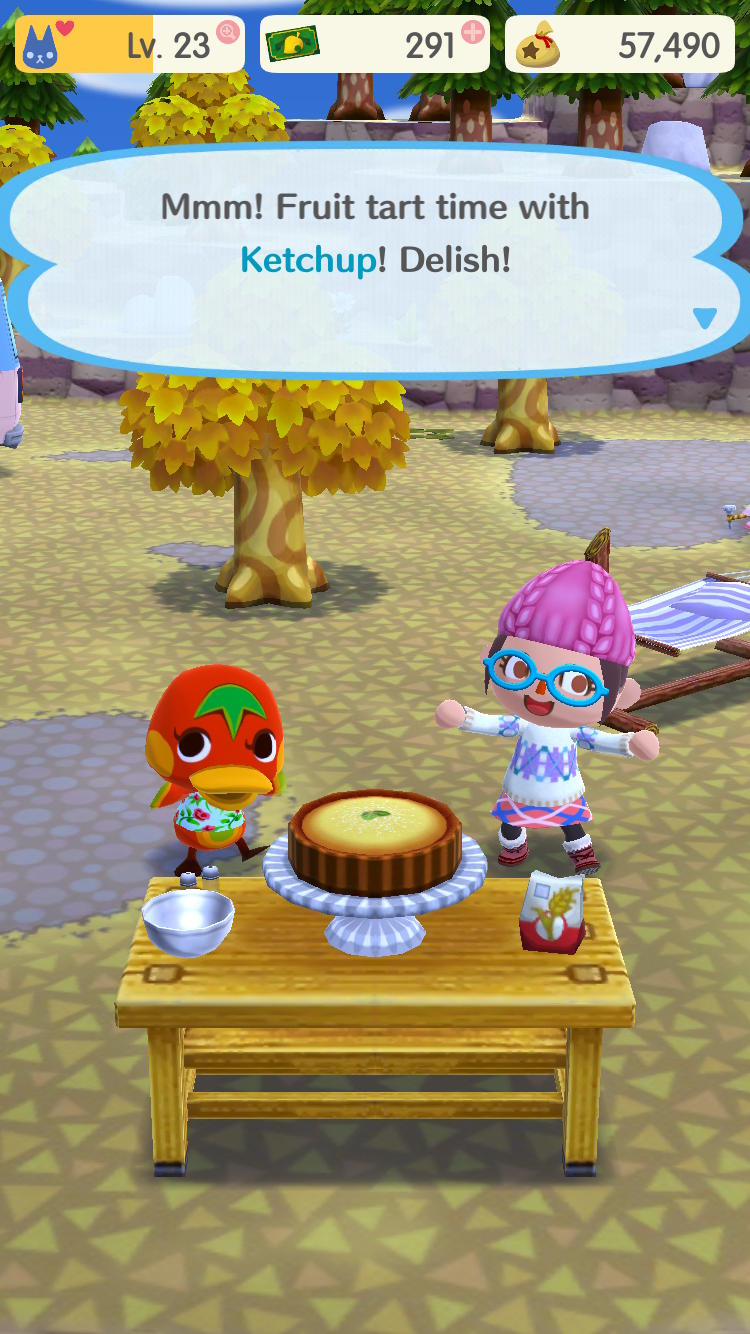
The world of Pocket Camp is split into a series of islands that you travel between via a map selection screen. While you are free to wander and explore each area, they are self-contained and separate islands cannot be accessed on foot. Although this makes the world feel slightly less cohesive at first, it greatly cuts down on travel time and aimless wandering, allowing you to jump straight to each key area whenever you like. If you need fruit, you can go directly to the island with fruit trees, Breezy Hollow. If someone has requested a monarch butterfly, just head over to Sunburst Island where insects hang out.
At the center of these islands is your personal Campsite. When you first begin Pocket Camp, Isabelle asks you to take over as the Campsite manager. Your job in this role is to make the Campsite as appealing as possible to potential visitors. Animal campers set up tents and hang out at four of the surrounding islands near the fruit and bugs, but they don’t stay long—they are camping, after all. If you befriend these animals and decorate your Campsite with furniture and amenities they’ll enjoy, the campers will come to stay on your island for good.
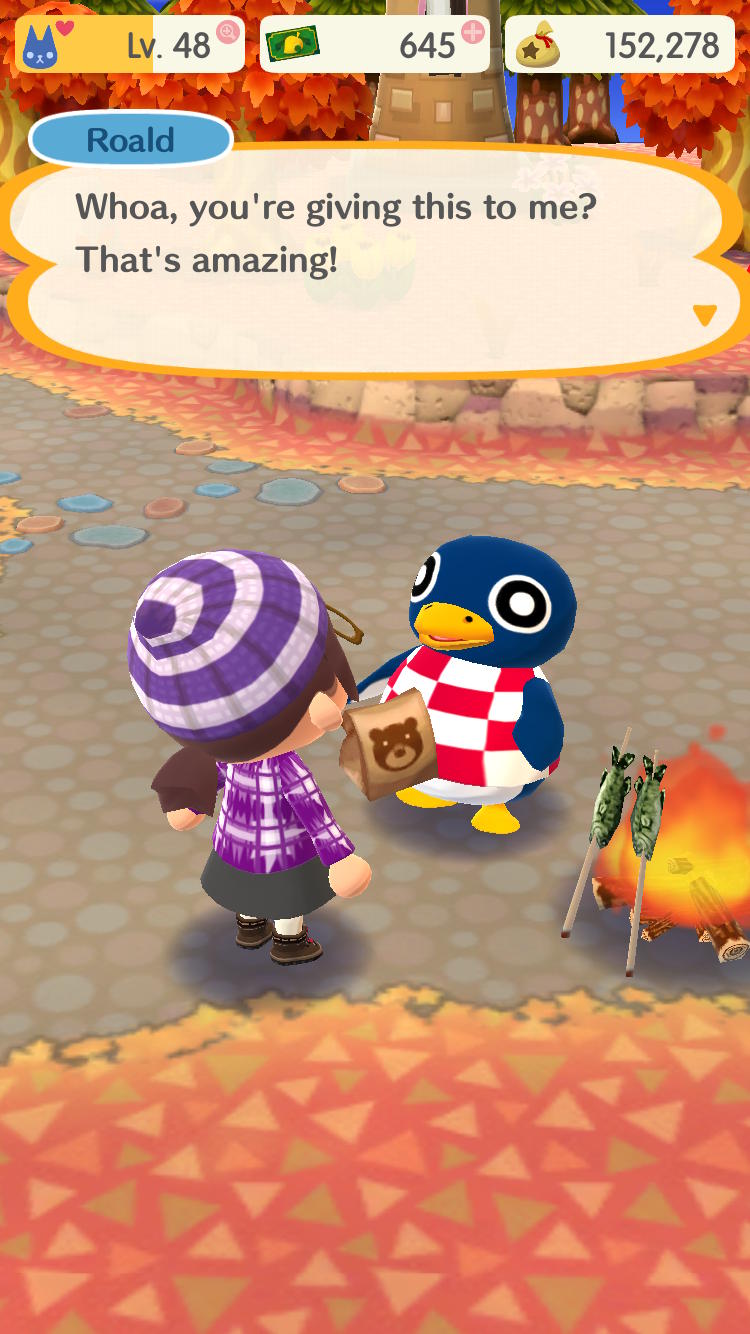
Befriending animals and decorating the Campsite is a cyclical process that benefits everyone. While camping out in the wilderness, animals will have requests for items you can gather around the islands. If you bring them these items, they’ll award you Bells and crafting materials and your friendship level will increase. You can then use what they’ve given you to build furniture for your Campsite that will make them want to visit.
Making friends and inviting those friends to the Campsite provide two concrete goals in an otherwise open-ended experience. Unlike the somewhat vague relationship levels in past Animal Crossing games, Pocket Camp utilizes a numerical points-based leveling system that makes it clear where you stand with each animal camper. Each animal must reach a specific friendship level to be invited to your Camp, and you see your progress toward that level every time you fulfill a request or view their personal bio page. Once an animal is successfully invited to the Campsite, they are added to the pool of visitors that can be invited back anytime, giving you instant access to your closest friends.
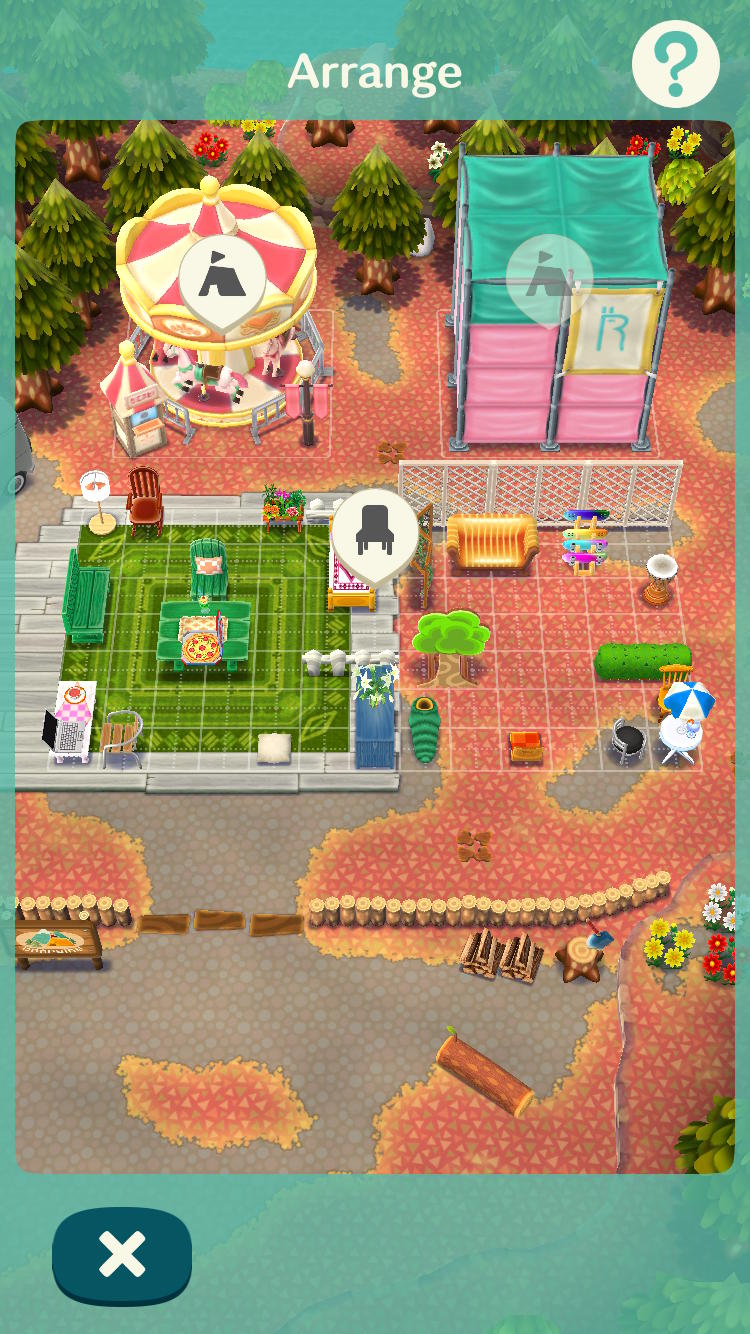
Decorating the Campsite is slightly reminiscent of Happy Home Designer: every animal has a selection of requested furniture you’ll need to include in your invitation arrangement, but you’re otherwise free to set it up however you like. There is a large area of outdoor space to work with from the very beginning, but you don’t have to specifically use “outdoor” items—you could place a fluffy rug, laptop, and TV so your animals don’t have to rough it. Although you can’t currently expand your decorating area, item placement is fairly forgiving: for instance, animals will sit in chairs that are positioned right next to other objects. You don’t need to leave walking space for your visitors (although you personally might want room to get around).
There are a wide variety of items to choose from and distinct styles related to animals’ personalities: the “cute” theme contains a lot of pink furniture decorated with hearts while the “cool” set features modern lines in dark grays and black. Everything can be mixed and matched, so your design options are only limited by the time and materials it takes to craft something new. One of our favorite aspects of decking out your Campsite is the fact that the animals actually use the items you set up: they sit on chairs and cushions, sleep in beds and hammocks, play with drums and guitars. There are some objects that are merely decorative, but the majority of your area will be filled with active animals enjoying your design handiwork.
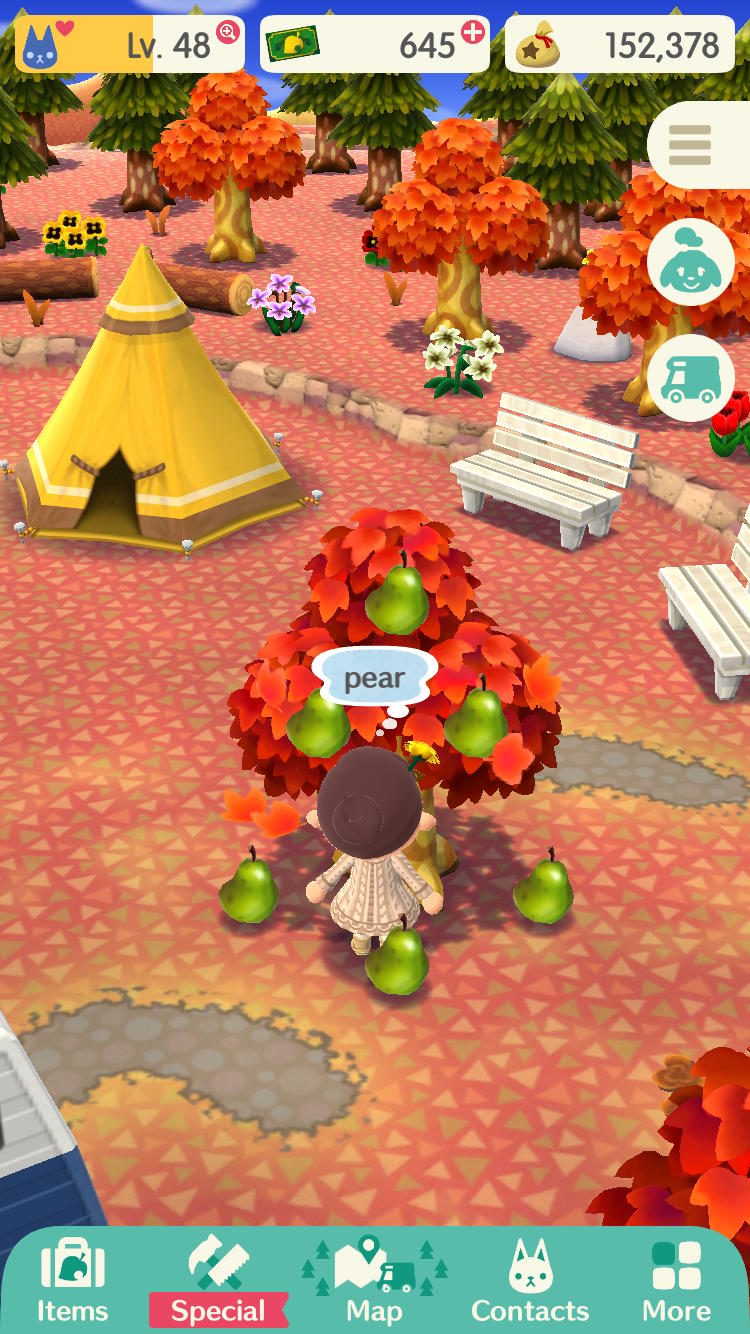
While becoming the friendliest Campsite manager and decorator around is the most obvious goal in the game, there are plenty of other activities available to fill your days. You can shake trees to gather fruit, toss a line into the river or ocean to snag fish, and get out your net and catch insects. The Able Sisters, Kicks, and Timmy Nook all set up shop on the Market Place island and sell clothing, accessories, and unique furniture (that cannot be crafted) for you to collect, wear, and use to decorate. You’ll run into other players’ avatars hanging around the islands: you can visit their Campsites to see how they’ve decorated, buy collected items from their personal Market Box, or send them a friend request so you can revisit them any time. You can fill up your own Market Box with extra fish, fruit, shells, and bugs to earn Bells; complete daily goals from Isabelle for extra items; visit Shovelstrike Quarry for more crafting materials; or work on completing your catalog of crafted furniture.
You can also spend time expanding and decorating your personal RV / camper that travels with you to every island you visit. The RV acts as a mobile house, complete with replaceable wallpaper and external paint options as well as a long string of upgrades and debt. Both areas can be decorated with all the same items (except the flooring and wallpaper, which are RV-specific), so it’s really just a separate space available for you to design outside of the Campsite.
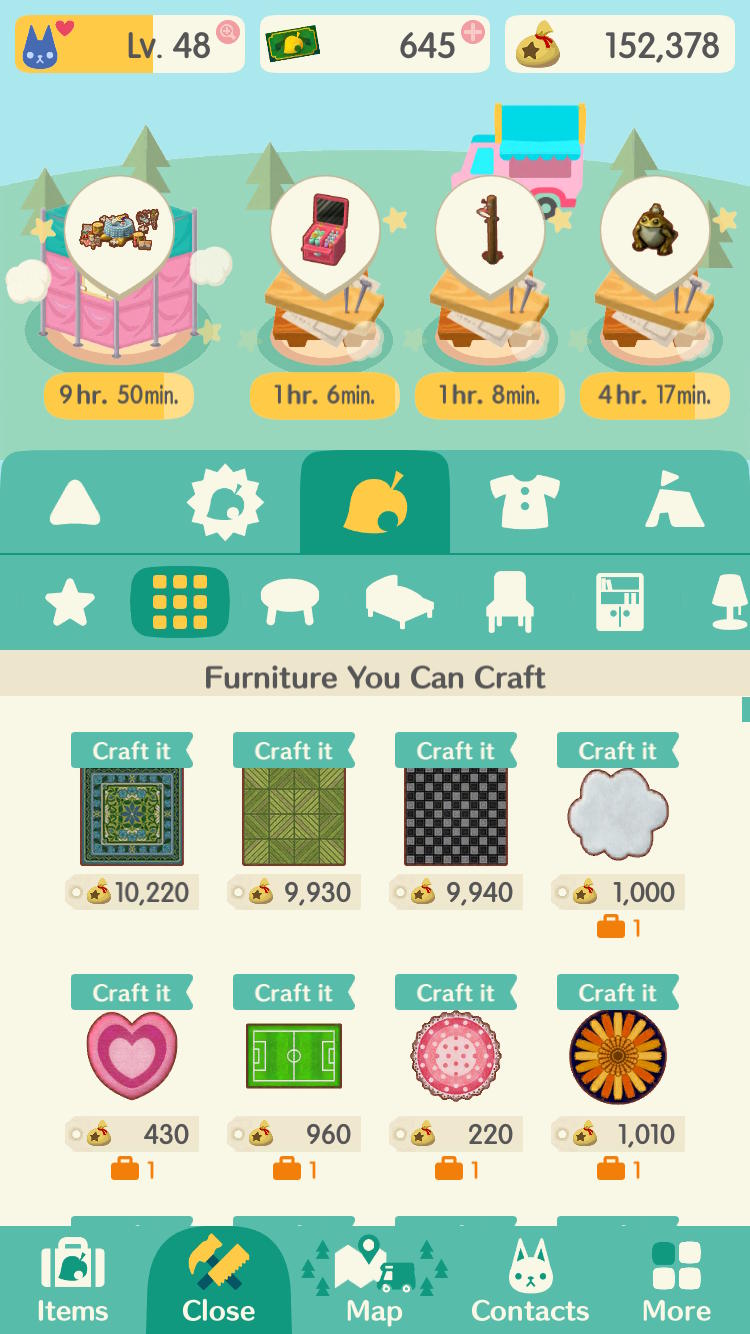
This all probably sounds, for the most part, like fairly classic Animal Crossing—and it is. The big difference comes from Pocket Camp’s time-based systems and additional currency that can be used to bypass them. While everything takes place in real-time—if you open the game at 3AM, half-asleep animals will yawn and be surprised by how late you stay up—there are separate timers on specific events. Crafting furniture requires Bells, crafting materials, and a specific amount of time. Many of the early pieces of furniture will finish crafting in only a minute, but as you progress in the game you’ll have to wait much longer. The large Campsite amenities, like the Tree House and Merry-Go-Round, take multiple real-life days of construction to be completed. You can wait for this time to pass—and it doesn’t prevent you from doing any of the other activities mentioned above—or spend Leaf Tickets to speed up the process.
There is also a rotation period every three hours: animals that are visiting the external islands will stay on those islands for three hours. After that time is up, those animals go “home” (they just exit the game temporarily) and the next random set appears. In the early game this doesn’t have a major impact on the experience—you’ll have only a small group of animals in the rotation anyway, so you’ll see the same campers regularly. Once all 40 animals have been unlocked (by leveling up through building friendships), you can go an entire day without running into a certain animal. This can make it challenging to build up friendship with a specific camper in order to invite them to your Campsite, especially if you cannot check in every three hours to see if they’ve appeared. In this case, you can use a Calling Card to make them appear immediately and a Request Ticket to do extra tasks for them to build up their friendship faster. Both of these items can be purchased with Leaf Tickets or earned in limited quantities through log-in bonuses and level-ups.
Yet despite the inclusion of a speed-up currency and the sometimes staggering length of time it takes to build amenities, Pocket Camp’s economy is ridiculously generous and non-predatory. The game doles out free Leaf Tickets almost too openly, making their purchase with real money completely optional. Most of their uses are simply an alternative to being patient and waiting a bit longer, and those that aren’t—permanent extra crafting and inventory slots—can easily be afforded with the Tickets you’ll earn from playing. With no ads or other in-app purchases, the result is a completely free and fulfilling Animal Crossing experience.
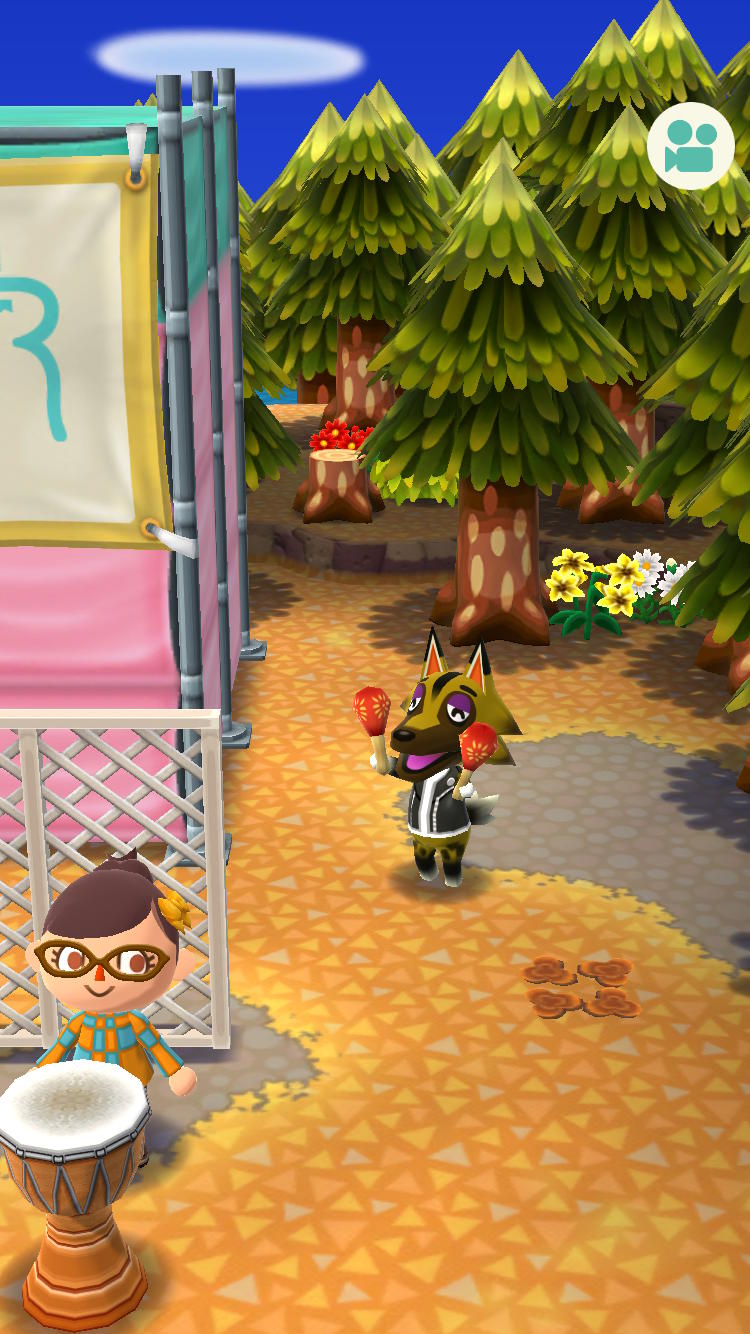
The greatest challenge to Pocket Camp’s success and longevity is simply how much Nintendo is willing to update it in the coming months. The current game has been available in Australia for just shy of one month, and in that time many players have completed essentially all of the “goals” that are available. They have unlocked and invited all 40 animals to stay at their Campsite; increased their friendships to the max level of 20; crafted all available furniture and built the large amenities; expanded their RV and paid off its final loan; and completed their clothing catalog. While the game doesn’t “end”—you can keep visiting animals, rearranging furniture, collecting materials, completing daily goals—there is a point where you’ll have seen and done all of the primary objectives, and that point has been reached by many players after less than a month.
Assuming Nintendo adds new animal campers, furniture, and clothing; allows for more expansions to your RV and (hopefully) the Campsite; opens up additional islands; and introduces holiday events to go along with the changing seasons, Pocket Camp will be a fantastic Animal Crossing game for years to come. The current iteration is already an exceptional transition of the series to mobile, complete with a large cast of animals with tons of adorable interactions and charming dialogue options (these animals are unapologetic coffee snobs); plenty of things to do, collect, and decorate; and the relaxing, open-ended gameplay we know and love coupled with more specific goals to work toward. The opportunity for regular future updates could make Pocket Camp the best Animal Crossing entry yet, but like every other real-time event in this series: we’ll have to wait and see.

The good
- Carries over all of the charm, attention to detail, and relaxing gameplay of the core Animal Crossing series.
- Tons of animals to befriend, furniture and clothing to collect, and activities to fill your days.
- Transparent and specific friendship levels, alongside the Campsite management, provide clear goals to work toward.
- Meeting and befriending other players offers a social incentive beyond just impressing your animal pals.

The bad
- Some minor quality of life issues, such as Market Boxes not being searchable and shop clothing not marked as already owned.
- Until new updates or content arrive, you can "do" everything in less than a month.
More articles...
Monopoly GO! Free Rolls – Links For Free Dice
By Glen Fox
Wondering how to get Monopoly GO! free rolls? Well, you’ve come to the right place. In this guide, we provide you with a bunch of tips and tricks to get some free rolls for the hit new mobile game. We’ll …The BEST Roblox Games of The Week – Games You Need To Play!
By Sho Roberts
Our feature shares our pick for the Best Roblox Games of the week! With our feature, we guarantee you'll find something new to play!All Grades in Type Soul – Each Race Explained
By Adele Wilson
Our All Grades in Type Soul guide lists every grade in the game for all races, including how to increase your grade quickly!Best Roblox Horror Games to Play Right Now – Updated Weekly
By Adele Wilson
Our Best Roblox Horror Games guide features the scariest and most creative experiences to play right now on the platform!







